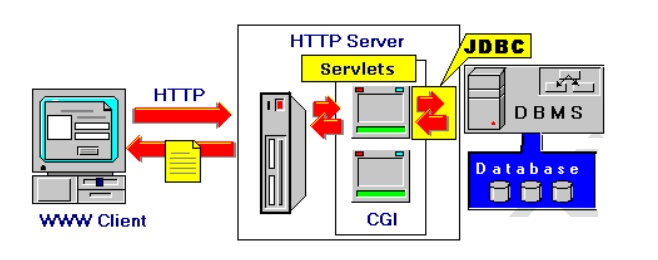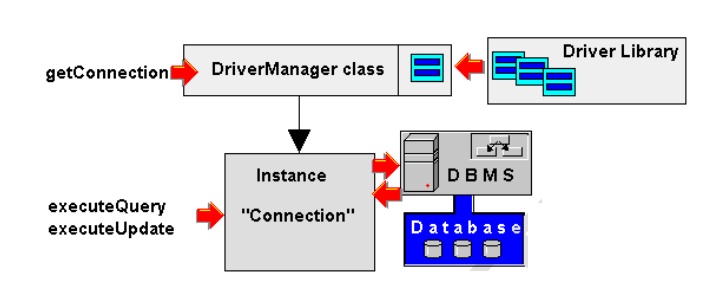Chapter: Web or internet Programming : Java Database Connector (JDBC)
Java Database Connector (JDBC)

Basic Principles
Basically, the JDBC API is a software library providing a number of Java
classes and interfaces that allows programmers to:
Ø Establish a connection to a wide range of different Relational Database
Management Systems (RDBMS). Note, that each major RDBMS, such as Oracle,
Microsoft SQL, or MySQL is supported.
Ø Access a database within a particular system.
Ø Manipulate the structure of a database by creating, deleting, or
altering relations from that database.
Ø Manipulate the content of a database by inserting, deleting, or updating
records in database relations.
Ø Retrieve the content from a database by querying the database.

Basically, the JDBC operates with two main classes:
1.
DriverManager class operates with
a library of drivers for different DBMS implementations. The DriverManager
class loads requested drivers, physically installs connrection to a database
and return an instance of a data class "Connection".
2.
An instance of the class
"Connection" represent a single connection to a particular database.
All the communication to the database is carryed out via this object.

Installing Connection:
Establishing JDBC Connection means obtaining a correct instance of
so-called "Connection"
class.
Usually, establishing a connection is carried out in two steps:
1.
loading an appropriate JDBC
driver for the installed RDBMS.
2.
installing connection and getting
reference to the Connection object Loading a JDBC driver is very simple and
involves just a single line of Java code.
...
try
{ Class.forName("com.mysql.jdbc.Driver"); }
catch(ClassNotFoundException exc){exc.printStackTrace();}
...
This line of code just notifyes the DriverManager which particular Java
class should be
loaded as a JDBC driver class.
The next step in establishing a database connection
is a message to loaded driver requesting actual connection to the RDBMS. The
operation is carryed out by sending message "getConnection" to the
driver manager. Note that "DriverManager" returns a
"Connection" instance that is used for further processing the
database.
try
{
...
Connection connection_;
String dbms = "jdbc:mysql://" + host + "/" + db;
connection_ = DriverManager.getConnection(dbms, username, password);
}
catch(ClassNotFoundException exc){exc.printStackTrace();}
Method "getConnection()" accepts three arguments:
1.
A so-called Database URL, which
encoded using standard URL syntax (protocol + host + object). The protocol part
starts always with "jdbc:" folowed by the name of the RDBMS (in our
case "mysql") and terminated with "://" symbols. Thus, the
protocol part in our example is "jdbc:mysql://". The host part
identifies a server where the DBMS is running. In our case (Servlets & DBMS
on the same computer) "localhost" can be used to identify the host.
Finally, the name of a particular database must be supplied preceeded with the
slash character. In our case this would be "/example".
2.
A registered username that has
the proper privileges for manipulating the database.
3.
A password valid for the
username.
Working with a Database
In order to actually work with a databaase, a special
"Statement" class is used.
In order to create an instance of such "Statement" class, a
message "createStatement" is sent to the previously created instance
of JDBC connection.
...
try
{
Statement statement = connection_.createStatement();
}
catch(SQLException exc)
{
exc.printStackTrace();
}
If an error occurs during the execution of the createStatement() method
a SQLException will be thrown. Instances of the Statement Class provides a
public interface to insert, update, or retrieve data from a database. Depending
on a particular database operation, an appropriate method should be invoked.
For instance,
•
executeUpdate() can be used to
insert data into a relation
•
executeQuery() can be used to
retrieve data from a database
...
try
{
String insert_sql_stmt = "INSERT INTO " +
table + " VALUES(" + values + ")"; statement.executeUpdate(insert_sql_stmt);
}
catch(SQLException exc){exc.printStackTrace();} ...
Other methods of the "statement" class can be also applyed to
its instances.
if we need to retrieve the keys automatically generated by the
"executeUpdate" statement, we need to pass the
"Statement.RETURN_GENERATED_KEYS" argument in advance.
try
{
String sql = "INSERT INTO " + table +
" VALUES(" + values + ")";
statement.executeUpdate(sql,Statement.RETURN_GENERATED_KEYS); ResultSet keys =
statement.getGeneratedKeys();
}
catch(SQLException exc){exc.printStackTrace();}
Similarly, to retrieve data from a database we need to obtain an
instance of the Statment class, and then to invoke executeQuery() method on
this instance. This method takes a string containing SQL source as an argument.
try
{
String sql = "SELECT ...";
ResultSet query_result = statement.executeQuery(sql);
} catch(SQLException
exc){exc.printStackTrace();}
Note, that the "sql" argument should contain a valid SQL
Select statement. The executeQuery() method returns an instance of the
ResultSet class. Generally, execution of any JDBC statement that returns data
from a database, results in an instance of the ResultSet class. This instances
may be seen as a number of rows (tuples) that hold the current results. The
number and type of columns in this object corresponds to the number and types
of columns returned as the result from the database system.
Consider the following sample database:
Customer(cn,cname,ccity);
Product(pn,pname,pprice);
Transaction(cn,pn,tdate,tqnt);
...
try
{
String sql = "SELECT * FROM Customer;";
ResultSet query_result = statement.executeQuery(sql);
...
The "executeQuery" command will result in obtaining an
instance of the ResultSet class which will hold all tuples from the Customer
table as rows, each row will contain 3 values: "cn",
"cname" and "ccity". Normally, the SQL statement exlicitly
defines the "ResultSet" internal structure. Once when we set a
current row of the ResultSet, we can retrieve values by means of a number of
methods. The methods correspond to a column type. Thus, to retrieve the value
of a string column, we invoke a getString() method. Similarily, to retrive an
integer value we simply invoke a getInt() method.
try
{
String sql = "SELECT cname, pname, qnt";
sql = sql + " FROM Customer, Product, Transaction";
sql = sql + " where Customer.ccity =
\"Graz\" And"; sql = sql + " Customer.cn = Transaction.cn
And"; sql = sql + " Transaction.pn = Product.pn";
ResultSet query_result = statement.executeQuery(sql);
while(query_result.next())
{
String customerName =
query_result.getString("cname"); String productTitle =
query_result.getString("pname"); int productQuantity =
query_result.getInt("cid");
... }
Related Topics